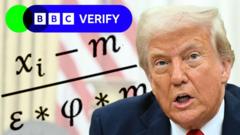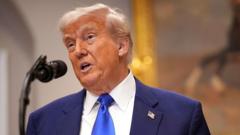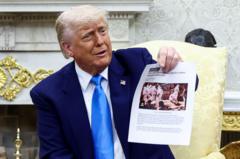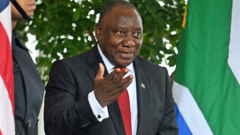This article dissects the methodology behind Donald Trump's imposed tariffs, highlighting the formula used and the implications for international trade.**
Understanding the Calculation Behind Trump's Tariffs: An In-Depth Look**

Understanding the Calculation Behind Trump's Tariffs: An In-Depth Look**
Analyzing the mathematical approach used by the Trump administration to determine import tariffs.**
US President Donald Trump's administration has implemented a 10% tariff on many goods imported into the United States, with increased rates for what he terms the "worst offenders." The detail of how these tariffs were calculated has drawn interest and scrutiny, prompting an analysis from BBC Verify. Initially, it was presumed that these charges were grounded in a mix of pre-existing tariffs and other trade barriers, but a more straightforward mathematical formula was later revealed.
According to the formula disclosed by the White House, the calculation hinges on the trade deficit between the US and a given country. Specifically, the trade deficit (the amount by which imports exceed exports) is divided by the total value of imports from that country and then halved. For instance, the US holds a $295 billion trade deficit with China against $440 billion in total imports, yielding a tariff of 34% after applying the formula. Conversely, the tariff imposed on the European Union was calculated at 20% using the same base.
Critics highlight that these tariffs are not reciprocal, as reciprocity would involve considering the tariffs and non-tariff barriers that other nations impose on US goods. The White House's methodology indicates a focus on eliminating bilateral trade deficits instead. This has resulted in tariffs against countries like the UK, where no trade deficit exists.
Trump has identified these tariffs as a mechanism to regenerate domestic manufacturing and safeguard American jobs, arguing that countries are taking advantage of the US by flooding markets with inexpensive goods. Nonetheless, economists express skepticism regarding the effectiveness of the tariff strategy. While such tariffs may lower trade deficits with particular countries, the overall US trade deficit may remain intact, driven by broader economic practices where Americans spend beyond their earnings.
Experts, like Thomas Sampson from the London School of Economics, contend that the tariff formula lacks a solid economic foundation and could detrimentally impact the global economy. The situation underscores the complexities of international trade dynamics and the multifaceted reasons behind trade deficits, which often extend beyond mere tariff imbalances.






















